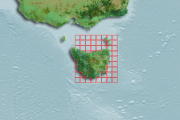Size
Type of resources
Topics
Keywords
Contact for the resource
Provided by
Years
-

Adult reproductive data for redbait is based on collections taken by midwater trawling during the spawning season and includes the biological information - size, sex, reproductive condition (weight and stage). Histological examination of mature ovaries provides information on spawing activity and preserved gonads are examined to determine batch fecundity.
-
Sampling of commercial mid-water trawl catches for small pelagics from waters adjacent to Tasmania have yielded an extensive biological dataset in space and time. As a minimum, size composition information is available from most commerical shots undertaken between 2002 and 2006, referenced with operational information (location, depth and catch weight). Subsamples of the key small pelagics, redbait, jack mackerel and blue mackerel, were examined for size, sex, gonad weight and stage and otoliths have been retained for age determination. Further data has been collected since the initial investigation.
-
Characterisation of lobster (Jasus edwardsii) abundance and change in abundance at three different sampling sites (Cape Paul Lemanon, North Bay and Fortescue Bay) on the south-east coast of Tasmania, was assessed by GPS tracked SCUBA diver swims of 60 minutes in length whereby GPS was logged approximately every 5 seconds. Large tagged Rock Lobsters were introduced into one of the sampling sites, North Bay (which was closed to fishing). The swims are also being used to assess the impact of reef closure on the local lobster population.
-
In fishing trials, the short term survival rates for hook caught flathead (Platycephalus bassensis in Tasmania and P. fuscus in Queensland) were examined to determine critical factors affecting post-release survival. Biological information (size) and hooking location/damage were recorded and fish held for several days in aquaria to assess survival rates. In order to relate hooking location and catch rates for a range of hook types (including circle hooks) structured fishing trials and volunteer fishers (using a diary system) provided information on fish size, hook type and hooking location.
 IMAS Metadata Catalogue
IMAS Metadata Catalogue